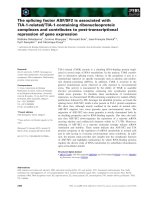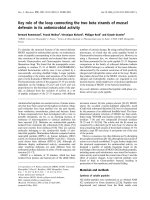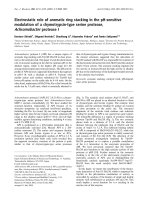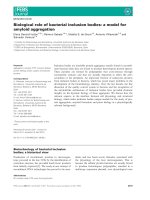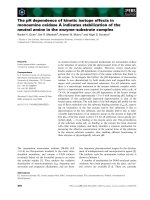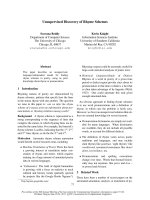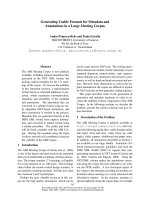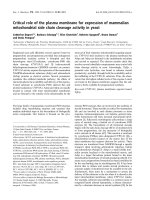Báo cáo khoa học: The role of residues R97 and Y331 in modulating the pH optimum of an insect b-glycosidase of family 1 pdf
Bạn đang xem bản rút gọn của tài liệu. Xem và tải ngay bản đầy đủ của tài liệu tại đây (428.16 KB, 10 trang )
The role of residues R97 and Y331 in modulating the pH optimum
of an insect b-glycosidase of family 1
Sandro R. Marana, Lu
´
cio M. F. Mendonc¸a, Eduardo H. P. Andrade, Walter R. Terra and Cle
´
lia Ferreira
Departamento de Bioquı
´
mica, Instituto de Quı
´
mica, Universidade de Sa
˜
o Paulo, Brazil
The activity of the digestive b-glycosidase from Spodoptera
frugiperda (Sfbgly50, pH optimum 6.2) depends on E399
(pK
a
¼ 4.9; catalytic nucleophile) and E187 (pK
a
¼ 7.5;
catalytic proton donor). Homology modelling of the
Sfbgly50 active site confirms that R97 and Y331 form
hydrogen bonds with E399. Site-directed mutagenesis
showed that the substitution of R97 by methionine or lysine
increased the E399 pK
a
by 0.6 or 0.8 units, respectively,
shifting the pH optima of these mutants to 6.5. The substi-
tution of Y331 by phenylalanine increased the pK
a
of E399
and E187 by 0.7 and 1.6 units, respectively, and displaced the
pH optimum to 7.0. From the observed DpK
a
it was calcu-
lated that R97 and Y331 contribute 3.4 and 4.0 kJÆmol
)1
,
respectively, to stabilization of the charged E399, thus
enabling it to be the catalytic nucleophile. The substitution of
E187byDdecreasedthepK
a
of residue 187 by 0.5 units and
shifted the pH optimum to 5.8, suggesting that an electro-
static repulsion between the deprotonated E399 and E187
may increase the pK
a
of E187, which then becomes the
catalytic proton donor. In short the data showed that a
network of noncovalent interactions among R97, Y331,
E399 and E187 controls the Sfbgly50 pH optimum. As those
residues are conserved among the family 1 b-glycosidases, it
is proposed here that similar interactions modulate the pH
optimum of all family 1 b-glycosidases.
Keywords: b-glycosidase; pK
a
values; pH optimum; site-
directed mutagenesis; Spodoptera frugiperda.
The b-glycosidases from glycoside hydrolase family 1 are
enzymes that remove monosaccharides from the nonreduc-
ing end of di- and/or oligosaccharides. According to the
CAZy website this family comprises 422 sequenced
b-glycosidases, of which the tertiary structure of 12 has
been determined. Together with families 2, 10, 17, 26, 30, 35,
39, 42, 51, 53, 59, 72, 79 and 86 family 1 forms clan A,
a group of families that shares structural and catalytic
similarities [1]. All b-glycosidases of family 1 present the
same tertiary structure [the (b/a)
8
barrel], they are configur-
ation-retaining glycosidases and their catalytic activity
depends on two glutamic acid residues, one positioned
after bstrand 4 and the other after b strand 7 [1]. These
glutamic acids are very close inside the active site (about
4.5 A
˚
apart) [2], and during the reaction the first glutamic
acid acts as proton donor, and the second acts as a
nucleophile. The catalytic nucleophile pK
a
is around 5.0 and
the catalytic proton donor pK
a
is around 7.0 [3–7].
Aplotofb-glycosidase activity vs. pH presents a bell
shape, indicating that in the pH optimum the catalytic
nucleophile is deprotonated and the catalytic proton donor
is protonated. Hence the branch of the curve below the pH
optimum is determined mainly by the ionization of the
catalytic nucleophile, whereas the catalytic ionization of the
proton donor determines the branch above the pH
optimum.
As the b-glycosidase activity depends on the finely
tuned ionization of the catalytic nucleophile and proton
donor, it is necessary to understand how the ionization of
these residues is modulated in order to determine how the
pH optimum is controlled. Such data are lacking for
family 1. In family 11 xylanases, it was proposed that the
negatively charged nucleophile electrostatically destabilizes
the proton donor ionization, increasing its pK
a
[8]. Thus,
one may hypothesize that the Ôelectrostatic couplingÕ
between the catalytic glutamates could also operate in
family 1, despite the fact that the family 11 and 1 belong
to different clans. However, even this interaction is not
enough to determine which of the glutamic acid residues
will be the catalytic nucleophile or the proton donor. This
is because for b-glycosidases it is not known how the
ionization of each catalytic glutamate is modulated and
therefore there is no model to explain how the pH
optimum is determined.
In this work a digestive b-glycosidase from Spodoptera
frugiperda (Sfbgly50) was used as an experimental model to
fill those gaps. This enzyme had been previously sequenced
(GenBank accession number AF052729) and it was classi-
fied in the glycoside hydrolase family 1. Catalytic activity of
Sfbgly50 depends on residues E399 (catalytic nucleophile,
pK
a
¼ 4.9) and E187 (catalytic proton donor, pK
a
¼ 7.5).
Correspondence to S. R. Marana, Departamento de Bioquı
´
mica,
Instituto de Quı
´
mica, USP, CP 26077, Sa
˜
o Paulo, 05513–970, Brazil.
Fax: +55 11 30912186, E-mail:
Abbreviations: MU, 4-methylumbelliferyl; MUbglc, 4-methylumbel-
liferyl b-
D
-glucopyranoside; NPbglc, p-nitrophenyl, b-
D
-gluco-
pyranoside; Sfbgly50, digestive b-glycosidase (Mr 50 000) from
Spodoptera frugiperda; ES, enzyme substrate.
Enzyme:digestiveb-glycosidase from Spodoptera frugiperda
(b-
D
-glucoside glucohydrolase; EC 3.2.1.21; GenBank accession no.
AF052729).
(Received 18 July 2003, revised 25 September 2003,
accepted 21 October 2003)
Eur. J. Biochem. 270, 4866–4875 (2003) Ó FEBS 2003 doi:10.1046/j.1432-1033.2003.03887.x
The effect of pH on Sfbgly50 activity is a typical bell-shaped
curve and the pH optimum is 6.2 [9].
In the active site of the family 1 b-glycosidases the
catalytic nucleophile and proton donor are very close
(4.5 A
˚
apart). Hence differences in their ionization and
resulting catalytic roles should rely on noncovalent inter-
actions that are specific for each residue. Structural data
on different family 1 b-glycosidases showed out that the
catalytic nucleophile interacts with an arginine and a
tyrosine, putatively being stabilized by them [10–13].
Homology modelling the Sfbgly50 active site confirms
that Y331 and R97 are positioned very close to E399 (less
than 3 A
˚
apart), suggesting that these residues are
hydrogen bonded with the catalytic nucleophile (Fig. 1).
Therefore, these interactions may affect the E399 ioniza-
tion so that this residue becomes the catalytic nucleophile,
whereas an electrostatic repulsion between E399 and E187
cause this last one to function as the catalytic proton
donor. Thus, interactions between E399 and Y331 or R97
may be key elements in the determination of Sfbgly50 pH
optimum.
The role of arginine in the modulation of the
b-glycosidase pH optimum had not been studied before.
The substitution of Y298 for phenylalanine in Agrobacte-
rium sp. b-glucosidase affected the rate constant of the
glycosylation step and also changed the enzyme pH
optimum [14]. Despite that, the effect of the tyrosine on
the pK
a
values of the b-glycosidase catalytic glutamates still
remains to be determined and quantified.
To fill these gaps, residues Y331, R97 and E187 of
Sfbgly50 were replaced through site-directed mutagenesis by
phenylalanine (Y331F), methionine (R97M), lysine (R97K)
and aspartate (E187D). The effect of pH on the activity of
the recombinant enzymes were then determined.
Materials and methods
Materials
All reagents, unless otherwise specified, were purchased
from Sigma or Merck.
Site-directed mutagenesis
Site-directed mutagenesis was performed using as template
the plasmid pT7-7 [15] containing as insert a DNA fragment
that encodes the mature Sfbgly50 (pT7b50) [9]. The
experiments were carried out following the instructions of
the QuikChange site-directed mutagenesis kit (Stratagene).
Primers used were: R97K, 5¢-GCCTGGACGCTTACA
AGTTCTCCCTCTCCTG-3¢ and 5¢-CAGGAGAGGGA
GAACTTGTAAGCGTCCAGGC-3¢; R97M, 5¢-GCCTG
GACGCTTACATGTTCTCCCTCTCCTG-3¢ and 5¢-CA
GGAGAGGGAGAACATGTAAGCGTCCAGGC-3¢;
Y331F, 5¢-GATCGGAGTGAACCACTTCACAGCATT
CCTGGTATC-3¢ and 5¢-GATACCAGGAATGCTGTG
AAGTGGTTCACTCCGATC-3¢; E187D, 5¢-GTTCATC
ACTTTCAACGATCCTAGAGAGATTTGCTTTGAG-3¢
and 5¢-CTCAAAGCAAATCTCTCTAGGATCGTTGA
AAGTGATGAAC-3¢. Codons in bold show the mutations.
The incorporation of the mutated codon in the pT7b50
was checked through DNA sequencing.
Expression of recombinant Sfbgly50
NovablueDE3 (Novagen) cells were cotransformed with
pT7b50 (encoding wild-type or mutant type Sfbgly50) and
pT-GroE, a plasmid encoding the chaperone GroELS
under the control of the T7 RNA polymerase promoter.
pT-GroE increases the Gro-ELS concentration inside the
cells and consequently it favours the folding of coexpressed
proteins [16]. The transformed bacteria were cultivated
(37 °C, 250 r.p.m.) in Luria–Bertani broth containing
carbenicillin (50 lgÆmL
)1
) and chloramphenicol
(17 lgÆmL
)1
) until D
600
¼ 0.6–1.0 was reached. The bac-
teria were then induced using 1 m
M
isopropyl thio-b-
D
-galactoside for 3 h (25 °C, 250 r.p.m.) and harvested at
7000 g for 20 min at 4 °C. The pellets were stored at
)80 °C. Samples of induced and noninduced cells were
analysed by SDS/PAGE [17] to detect the expression of the
recombinant b-glycosidases.
Lysis of induced bacteria
Induced bacteria were suspended in 50 m
M
Hepes buffer
pH 7.0 containing 150 m
M
NaCl, 0.02% (w/v) lysozyme
(chicken egg white) and 0.1% (v/v) Triton X-100. The
suspension was incubated at 4 °C with slow shaking
(3 r.p.m.). After 30 min, the cells in the suspension were
disrupted using a sonicator adapted with a micro tip (five
pulses of 30 s at output 4 in a Branson 250 sonicator) and
Fig. 1. Schematic representation of the Sfbgly50 active site. E399 is the
nucleophile and E187 is the proton donor. Y331 and R97 form
hydrogen bonds (dotted lines) with E399 (Y331 O
g
atom to E399 O
e1
atom ¼ 2.69 A
˚
and R97 N
g1
atom to E399 O
e2
atom ¼ 2.77 A
˚
). The
distance between E399 and E187 side chains is 4.5 A
˚
.
Ó FEBS 2003 Mechanism of pH optimum control in b-glycosidases (Eur. J. Biochem. 270) 4867
harvested at 7000 g for 20 min at 4 °C. The supernatant
was stored at )20 °C and used as source of recombinant
b-glycosidase.
Purification of the recombinant Sfbgly50
Soluble material from the induced cells containing the wild-
type or mutant recombinant Sfbgly50 was loaded onto a
phenylSuperose HR 10/10 column (Pharmacia Biotech).
The nonretained proteins were washed out with 50 m
M
phosphate buffer pH 7.0 containing 1.27
M
(NH
4
)
2
SO
4
,and
the retained proteins were then eluted using a gradient of
(NH
4
)
2
SO
4
prepared in 50 m
M
phosphate buffer pH 7.0.
ThepresenceoftherecombinantSfbgly50 was detected by
enzymatic assay using NPbglc (p-nitrophenyl b-
D
-glucopyr-
anoside) as substrate [18]. Fractions containing b-glycosi-
dase activity were pooled and dialysed in 20 m
M
triethanolamine buffer pH 8.0, and the dialysed material
was loaded onto a Resource Q column (Amersham Bio-
science). Nonretained proteins were washed out with 20 m
M
triethanolamine buffer pH 8.0 and retained proteins were
eluted using a gradient of NaCl prepared in the same initial
buffer. The presence of the recombinant Sfbgly50 was
detected as above and its purity ascertained by SDS/PAGE
followed by silver staining [19].
Protein determinations were performed spectrophotomet-
rically (absorbance in 280 nm) using e
280
¼ 117 200
M
)1
Æcm
)1
[20]. The same protocol was used to purify the
wild-type and mutant Sfbgly50.
The native Sfbgly50 was purified from the S. frugiperda
midgut following the procedures described previously [21].
Kinetic analysis
All assays were performed at 30 °Cin50m
M
citrate/
phosphate buffer pH 6.0 and initial rate data measured.
Hydrolysis of MUbglc (4-methylumbelliferyl b-
D
-glucopyr-
anoside) was followed by MU fluorescence [22]. Kinetic
parameters (k
cat
and K
m
) were determined by using nine
different substrate concentrations (0.1–8 m
M
); enzyme
concentrations were 0.13 l
M
for R97M, 0.09 l
M
for
Y331F and 0.62 l
M
for E187D. The data were fitted to
Michaelis–Menten equation using the
ENZFITTER
(Elsevier-
Biosoft).
Chemical modification with phenylglyoxal
Arginine modification was performed using different
concentrations of phenylglyoxal (1, 3, 4 and 5 m
M
)
prepared in 20 m
M
phosphate buffer pH 8 at 30 °C. In
this pH phenylglyoxal reacts specifically with arginine
residues [23,24]. Wild-type (0.49 l
M
)ormutantSfbgly50
(0.13 l
M
) samples were incubated with the modifying
agent in the absence or presence of high concentration of
NPbglc (> 4 · K
m
). Samples were collected after differ-
ent periods of time and 10 m
M
arginine in 20 m
M
phosphate pH 8.0 was added. This material was used to
determine the remaining enzymatic activity using 4 m
M
MUbglc as substrate in 50 m
M
citrate/phosphate buffer
pH 6.0. Then, the rate constants (k
obs
)fortheSfbgly50
inactivation in different phenylglyoxal concentrations were
calculated.
pH effect on the Sfbgly50 activity
Sfbgly50 enzymatic activity on 8 m
M
MUbglc was deter-
mined in different buffers ranging from pH 5.0 to 8.5
(50 m
M
citrate/phosphate buffer, pH 5.0–7.0; 50 m
M
phos-
phate buffer, pH 7.0–8.0; 50 m
M
Bicine buffer 7.0–8.5). The
pH stability of Sfbgly50 was checked by incubation in the
same buffers for a time equal to the assay time and then
determining the activity remaining at the optimum pH. To
correct the pH shifts due to differences in temperature,
pH of the assay media was measured in substrate/buffer
mixtures at 30 °C. The enzyme concentration was 0.13 l
M
for mutant R97M, 0.09 l
M
for mutant Y331F and 0.37 l
M
for mutant E187D.
At 8 m
M
MUbglc, Sfbgly50 is approaching saturation by
the substrate. Hence, relative activity is a good approxima-
tion of the relative maximum velocity (V
max app
) under these
conditions. Thus the pK
a
s in the enzyme–substrate (ES)
complex of the catalytically active groups of Sfbgly50
(pK
ES1
and pK
ES2
) were determined by fitting the V
max app
of the MUbglc hydrolysis at each pH to Eqn (1) [25].
V
max app
¼
1
1 þ
H
þ
ÂÃ
K
ES1
þ
K
ES2
H
þ
ÂÃ
ð1Þ
V
max app
is the relative V
max
determined at each pH, [H
+
]
is the proton concentration and K
ES1
and K
ES2
are the
ionization constants of the two catalytically essential groups
in the ES complex. V
max app
was expressed as a percentage
of the highest V
max
observed, and fitting was done using the
software
ENZFITTER
.
Ionization constants in the free enzyme (pK
E1
and pK
E2
)
were calculated using Eqn (2) [25].
k
cat
=K
mapp
¼
1
1 þ
H
þ
ÂÃ
K
E1
þ
K
E2
H
þ
ÂÃ
ð2Þ
k
cat
/K
mapp
is the relative k
cat
/K
m
determined at each pH, [H
+
]
is the proton concentration and K
E1
and K
E2
are the ionization
constants of the two catalytically essential groups in the free
enzyme. k
cat
/K
mapp
may be calculated from the enzymatic
activity determined using low substrate concentration
(0.25 m
M
) at different pH values and relative k
cat
/K
mapp
and [H
+
] were fitted in the above equation using
ENZFITTER
.
The data were enough to fit simultaneously the two K
ES
and K
E
. In the E187D mutant, the determination of pK
ES1
was less accurate than that of pK
ES2
, because many more
points above the pH optimum were obtained. However, it
was not possible to go below pH 5.0 because Sfbgly50
becomes unstable.
Homology modelling
The three-dimensional structure of Sfbgly50 was modelled
according to structural data for Bacillus polymyxa
b-glucosidase A (1BGA, 1BGG, 1TR1), Trifolium repens
b-glucosidase 2 (1CBG) and Lactococcus lactis 6-phospho
b-galactosidase (1PBG). Modelling was performed in the
Swiss Model server and the result was visualized by
PDBVIEWER
[26].
4868 S. R. Marana et al. (Eur. J. Biochem. 270) Ó FEBS 2003
Sequence alignment and structural comparison
Amino acid sequences of family 1 b-glycosidases were
retrieved from the CAZy website [1] and aligned using the
software
CLUSTALX
[27]. The spatial coordinates of family 1
b-glycosidases were retrieved from the PDB website and
visualized by
PDBVIEWER
[26].
Results
The expression of recombinant wild-type and mutant
Sfbgly50 was checked by SDS/PAGE (Fig. 2A). Recom-
binant Sfbgly50 was purified by a combination of hydro-
phobic and anion-exchange chromatography (Fig. 2B),
resulting in a 50% recovery and a yield of about 0.2 mg
purified Sfbgly50 from 0.5 L bacterial culture (Fig. 2C).
The kinetic parameters (k
cat
and K
m
) for the hydrolysis of
MUbglc were determined for the Sfbgly50 mutants (R97M,
Y331F and E187D) and compared with those of the wild-
type enzyme (Table 1). All mutations resulted in a large
activity decrease, indicating that R97 and Y331 do influence
catalysis.
The pH-dependent activity profile is similar for the native
and recombinant wild-type Sfbgly50 (Fig. 3). Hence the
recombinant wild-type Sfbgly50 is useful as a control in
comparisons with the Sfbgly50 mutants. Moreover, wild-
type and mutant Sfbgly50 are stable in the pH range 5.0–9.0
(Fig. 3).
As the kinetic data showed that R97 and Y331 influence
catalysis, the function of residue R97 was investigated by
performing a chemical inactivation of wild-type Sfbgly50
with phenylglyoxal. The reaction order was 1.7 in relation
to phenylglyoxal and the inactivation was halted by the
presence of saturating concentrations of substrate (Fig. 4).
In contrast, phenylglyoxal did not inactivate R97M and
R97K mutants (data not shown).
Enzyme activity–pH data showed that R97K and R97M
Sfbgly50 mutants presented curves narrower and pH
optimum (6.5) slightly higher than wild-type Sfbgly50 (6.2)
(Fig. 5A,B). The mutant Y331F presented an activity–pH
profile wider and a pH optimum (7.0) higher than the wild-
type Sfbgly50, whereas the E187D mutant had a pH
optimum (5.8) lower than the recombinant wild-type
enzyme (Fig. 5C,D).
Fig. 2. Induction and purification of the recombinant Sfbgly50. (A)
SDS/PAGE of proteins from NovablueDE3 cells transformed with
plasmid pT7-7 containing Sfbgly50. Lane 1, Noninduced cells; lanes 2,
3, 4 and 5, cells induced to produce the mutants R97M, R97K, Y331F
and E187D, respectively. The arrow indicates the recombinant
Sfbgly50. The gel (10% polyacrylamide) was stained with Coomassie
blue R. (B) The soluble material from the bacteria producing the
R97M Sfbgly50 was loaded onto a Phenyl Superose HR 10/10 column
eluted with a decreasing gradient of (NH
4
)
2
SO
4
,preparedin50m
M
phosphate buffer pH 7.0. b-Glycosidase activity (r) was detected
using 2 m
M
NPbglc prepared in 50 m
M
citrate/phosphate buffer
pH 6.0. The two most active fractions were pooled. (C) Ion-exchange
chromatography in Resource Q column of the b-glycosidase activity
recovered in (B). Elution produced using a gradient of NaCl prepared
in 20 m
M
triethanolamine buffer pH 8.0. b-Glycosidase activity (r)
was detected using NPbglc. The three most active fractions were
pooled and analysed by SDS/PAGE. (D) SDS/PAGE of the purified
Sfbgly50. The gel (10% polyacrylamide) was silver stained. The same
procedure was used to purify the wild-type and mutant (R97K, Y331F
and E187D) Sfbgly50. As the gels are not the same size the band
positions are not directly comparable.
Ó FEBS 2003 Mechanism of pH optimum control in b-glycosidases (Eur. J. Biochem. 270) 4869
As the pK
a
values of the catalytic residues determine the
pH optima, the ionization constants (pK
a
)ofthecatalytic
glutamates (E187 and E399) in the ES complex and in the
free enzyme (E) of Sfbgly50 mutants were determined. The
pK
ES
and pK
E
are very similar, thus only the pK
ES
values
are presented (Table 2). The differences observed in pK
a
values between the wild-type and mutant enzymes result
from the modifications in the interactions between the
catalytic glutamates and the residues R97 and Y331,
indicating that these residues play a role in the modulation
of the Sfbgly50 pH optimum.
Sequence alignments and structural comparisons of
family 1 b-glycosidases showed that R97 and Y331 are
totally conserved and that these residues plus the nucleo-
phile (E399) have the same spatial positioning (Fig. 6).
Nevertheless, the distance between arginine and glutamate
varies from 2.59 to 3.64 A
˚
and the distance between the
tyrosine and glutamate varies from 2.59 to 2.98 A
˚
.
Discussion
An inspection of the three-dimensional structure of some
family 1 b-glycosidases [10–13] and of the structural model
of the Sfbgly50 active site show that an arginine (R97) and a
tyrosine (Y331) are very close (2.69 A
˚
and 2.77 A
˚
, respect-
ively) and form hydrogen bonds with the side chain of E399.
The hydrogen bond between R97 and E399 probably has a
strong electrostatic component. However, determination of
the relative contribution of each component in this inter-
action is not simple. On the other hand, E399 is also close
to E187 side chain (4.5 A
˚
) and these residues may interact
electrostatically (Fig. 1). These noncovalent interactions
may modulate the E187 and E399 ionization state and
consequently determine the Sfbgly50 pH optimum. In order
to test this hypothesis, some mutants (R97M, R97K, Y331F
and E187D) were expressed as recombinant proteins in
Escherichia coli. The general shape and volume of residues
97 and 331 side chains are conserved in the mutants R97M
and Y331F, but the hydrogen bond-forming atoms have
been removed. In mutant E187D, the distance between the
catalytic nucleophile and the catalytic proton donor has
been increased because the side chain of aspartic acid is
shorter than that of glutamic acid.
The kinetic parameters for MUbglc hydrolysis (Table 1)
show that the substitution of R97 and Y331 results mostly
in a decrease in k
cat
,whereasK
m
is affected less, suggesting
that these residues influence catalysis. As a member of the
glycoside hydrolase family 1, the Sfbgly50 probably follows
a double displacement mechanism with a glycosyl-enzyme
intermediate. However, as it is not known which step
(glycosylation or deglycosylation) of the hydrolysis of
MUbglc by the mutant enzymes is rate-limiting, no hypo-
thesis on the effect of R97 and Y331 on the rate constant of
each step can be advanced.
Table 1. Steady-state kinetic parameters for hydrolysis of MUbglucoside by recombinant wild-type and mutant Sfbgly50. The experiments were
carried out at nine different substrate concentrations and the parameters were calculated using
ENZFITTER
.
K
m
(m
M
)
k
cat
(s
)1
)
k
cat
/K
m
(s
)1
Æm
M
)1
)
k
cat
/K
m
relative
Wild-type 2.3 ± 0.1 1.73 ± 0.09 0.75 ± 0.06 100
R97M 1.9 ± 0.3 0.0030 ± 0.0002 0.0015 ± 0.0005 0.2
Y331F 2.0 ± 0.5 0.0070 ± 0.0005 0.003 ± 0.001 0.45
E187D 4.4 ± 0.1 0.00147 ± 0.00002 0.00033 ± 0.00001 0.044
Fig. 3. Effect of pH on the activity of native (j)andrecombinant(s)
wild-type Sfbgly50. The buffers used were 50 m
M
citrate/phosphate
(pH 4.7–7.0), 50 m
M
phosphate (pH 7.0–8.0) and 50 m
M
bicine
(pH 8.0–8.5). Each point is the average of four Sfbgly50 activity
determinations using 4 m
M
MUbglc as substrate. The pH stability of
the recombinant Sfbgly50 (n) was checked by incubating the enzyme
in the same buffers for an equal length of time and determining the
remaining activity in the pH optimum.
Fig. 4. Inactivation of the Sfbgly50 with phenylglyoxal. Effect of
phenylglyoxal concentration (r,1m
M
; j,3m
M
; m,4m
M
; d,5m
M
)
on the inactivation rate of the wild-type recombinant Sfbgly50. Phe-
nylglyoxal was prepared in 20 m
M
phosphate buffer pH 8.0. The
inactivation order is 1.7 with phenylglyoxal as calculated from the
insert. Enzymatic activity was detected using as substrate 4 m
M
MUbglc in 50 m
M
citrate/phosphate pH 6.0.
4870 S. R. Marana et al. (Eur. J. Biochem. 270) Ó FEBS 2003
The influence of R97 on catalysis is confirmed by the
phenylglyoxal inactivation (Fig. 4), which is abolished by
substrate and is not observed with the R97M and R97K
mutants. The reaction order relative to phenylglyoxal (1.7)
indicates that the enzyme is inactivated by the reaction of
two phenylglyoxal molecules with one arginine residue.
Despite the fact that the reaction mechanism is not clear (a
dimer or two phenylglyoxal molecules may react with one
arginine residue), the reaction order (1.7) is in agreement
with the proportion found in reactions between phenyl-
glyoxal and polypeptides (2 : 1) [23]. The structure of the
putative reaction product [23] indicates that the modified
R97 side chain is unable to hydrogen bond with E399,
probably causing wild-type Sfbgly50 inactivation. More-
over, the addition of a bulky group (diphenylglyoxal) in the
active site probably hinders substrate binding.
The substitution of R97 by M results in a 500-fold
decrease in k
cat
, whereas the replacement of Y331 by F
results in a 250-fold decrease (compare k
cat
for the wild-type
and mutant Sfbgly50 in Table 1). As the extent of k
cat
decrease is similar in both cases, R97 and Y331 may have a
similar influence on catalysis. In a b-glycosidase from
Agrobacterium sp. (glycoside hydrolase family 1), the
replacement of the residue equivalent to Y331 (Y298,
Agrobacterium numbering) for a phenylalanine also results
in a large k
cat
decrease (500-fold) [14].
One possible effect of R97 and Y331 on catalysis is to
position E399. Thus, the k
cat
decrease could result from an
incorrect positioning of the catalytic nucleophile, but the
data presented here are not enough to support this
hypothesis.
In the case of the Y331F mutant part of the decrease in
k
cat
may result from destabilization of the ES complex,
because the tyrosine residue is thought to interact with the
oxygen of the glycone ring in that complex [10,12].
Nevertheless, it is not possible to assume that the same is
occurring in the mutant R97M, because there is no data on
the interactions between the substrate and the arginine
residue.
Finally, another aspect of the R97 and Y331 influence on
catalysis that must be taken into account is the modulation
of the ionization state of the catalytic glutamates. Indeed,
the substitution of R97 by M, which disrupts the hydrogen
bond between residue 97 and E399, shifted the E399 pK
a
by
+0.6 pH units (from 4.8 to 5.4), but had no effect on the
E187 pK
a
. As a consequence of the higher pK
a
of E399, the
mutant R97M has a pH optimum (6.5) slightly higher than
that of wild-type Sfbgly50 (6.2).
Although the introduction of a methionine residue at
position 97 could have changed the dielectric constant of the
active site, the deletion of the hydrogen bond between R97
and E399 is probably a major cause of the shift in the pK
a
of E399. Therefore, R97 facilitates the ionization of the
catalytic nucleophile by stabilizing its charged state.
Fig. 5. Effect of pH on the relative maximum velocity (V
maxapp
)ofthe
wild-type (s) and mutant Sfbgly50 (j). (A) R97K; (B) R97M; (C)
Y331F; (D) E187D. The buffers used were 50 m
M
citrate/phosphate
(pH 4.7–7.0), 50 m
M
phosphate (pH 7.0–8.0) and 50 m
M
bicine
(pH 8.0–8.5). Each point is the average of four Sfbgly50 activity
determinations using 8 m
M
MUbglc as substrate. The enzymes are
stable in this pH range. Based on these data, pK
ES1
and pK
ES2
values
were calculated as described in the Material and methods.
Table 2. pK
a
values of the catalytic groups in the ES complex of the
wild-type and mutants Sfbgly50.
pK
ES1
pK
ES2
DpK
ES1
DpK
ES2
Wild-type 4.8 ± 0.1 7.4 ± 0.1 – –
R97K 5.6 ± 0.1 7.7 ± 0.1 +0.8 +0.3
R97M 5.4 ± 0.1 7.5 ± 0.1 +0.6 +0.1
Y331F 5.5 ± 0.1 9.0 ± 0.1 +0.7 +1.6
E187D 4.5 ± 0.1 6.9 ± 0.1 )0.3 )0.5
Ó FEBS 2003 Mechanism of pH optimum control in b-glycosidases (Eur. J. Biochem. 270) 4871
The observed DpK
a
are directly related to the differences
in the free energy change (DDG° ¼ 2.303RTDpK
a
)of
ionization of the groups in wild-type and mutant enzyme.
This ionization differs because of the stabilizing effect
provided by R97, which is lacking in the mutant R97M.
Hence, the DDG° is equal to the energy of the stabilizing
effect provided by R97. Thus, based on the DpK
a
of E399
between the wild-type and R97M Sfbgly50, it was calculated
that R97 contributes 3.4 ± 0.4 kJÆmol
)1
to stabilize the
charge of E399.
In the R97K mutant the pK
a
of E399 is shifted by
+0.8 pH units, whereas pK
a
of E187 changed by +0.3 pH
Fig. 6. Sequence alignment and structural comparison of family 1 glycoside hydrolases. (A) Sequence alignment of the regions containing the residue
R97 and Y331 (Sfbgly50 numbering). The aligned b-glycosidases are from Actinomyces naeslundii AAK33123.1, Agrobacterium sp. AAA220851,
Arabidopsis thaliana Q9SE50, Bacillus circulans Q03506, Bacillus polymyxa P22073, Brassica napus Q42618, Catharanthus roseus AAF28800.1,
Cavia porcellus P97265, Clostridium longisporum Q46130, Escherichia coli K12 P11988, Lactobacillus caseii P14696, Lactococcus lactis P11546,
Prunus serotina AAL06338.1, Pyrococcus woesei O52626, Sinapis alba P29092, Spodoptera frugiperda AF052729, Staphylococcus aureus P11175,
Sulfolobus solfataricus P22498, Thermus nonproteolyticus AAF36392.1, Trifolium repens P26205, Zea mays P49235. An asterisk marks identical
residues, a colon indicates strongly conserved residues and a period denotes weakly conserved residues. (B) The spatial position of the residues
corresponding to Y331, E399 and R97 (Sfbgly50 numbering) in different glycoside hydrolases was superimposed. The spatial coordinates were
retrieved from PDB: 1BGG, b-glycosidase from Bacillus polymyxa (black; R77, Y296 and E352); 2MYR, myrosinase from Sinapis alba (green;
R95, Y330 and E409); 1CBG, cyanogenic b-glycosidase from Trifolium repens (orange; R91, Y326 and E397); 1PBG, phospho b-galactosidase from
Lactococcus lactis (red; R72, Y299 and E374).
4872 S. R. Marana et al. (Eur. J. Biochem. 270) Ó FEBS 2003
units (Table 2). Taking into account the experimental
errors, the pK
a
of E187 remained the same, but the pK
a
of
E399 clearly increased. Actually, the substitution of R97 by
methionine or lysine resulted in the same increment in the
pK
a
of E399 (Table 2). Therefore, M97 and K97 are equally
effective in stabilizing the charged E399. That is unexpected,
because as arginine and lysine side chains are positively
charged and hydrogen bond donors, they should interact
similarly with E399. However, it should be considered that
structural data of high resolution protein structures indicate
that the geometry of the hydrogen bonds formed by those
residues are very different [28] and that lysine side chain is
shorter. Thus, the present results suggest that in spite of the
fact that K97 could form a hydrogen bond with E399, this
bond is weakened or disrupted because of unfavourable
spatial positioning of interacting atoms. Alterations in the
active site structure could also contribute to the observed
result.
In the Y331F mutant the replacement of Y331 for
phenylalanine shifted the pK
a
of E399 by +0.7 pH units
(from 4.8 to 5.5) and the pK
a
of E187 by +1.6 pH units
(7.4–9.0). As a result, the pH optimum of the Y331F mutant
(7.0) is higher than that of the wild-type Sfbgly50 (6.2)
(Fig. 5). The effect of this mutation on the E399 ionization
is the same as observed for the mutation R97M
(DpK
ES1
¼ + 0.6; Table 2), indicating that Y331 also
stabilizes the charged E
399
. Part of this effect may result
from an alteration of the dielectric constant of the active site,
although the deletion of the hydrogen bond between Y331
and E399 is probably a major component of that pK
a
increment. Based on the DpK
a
of E399 between the wild-
type and Y331F Sfbgly50 it was calculated that the Y331
contributes 4.0 ± 0.4 kJÆmol
)1
to the stabilization of the
charged E399, the same value observed for R
97
.Therefore,
R97 and Y331 together contribute 7.4 kJÆmol
)1
to stabil-
ization of the charged E399. Hence, if these two residues
were removed, the ionization of E399 would be less
favourable and the pK
a
of E399 would be higher, probably
around 6.0.
In the Y331F mutant, the pK
a
of E187 was increased
by +1.6 pH units. This modification is not a result of a
direct interaction between E187 and Y331 as these
residues are far apart from each other. A possible
explanation is that the increase in the pK
a
of E399 makes
more difficult the ionization of E187 due to an increment
in electrostatic repulsion between these glutamates. How-
ever, this repulsion is not enough to completely explain
the DpK
a
of E187 in the Y331F mutant, because in the
R97K and R97M mutants the same increment in the pK
a
of E399 did not change significantly the pK
a
of E187. This
suggests that in the Y331F mutant, the charged side chain
of E399 may have moved to a new position closer to
E187, in order to minimize unfavourable interactions with
the apolar side chain of F331. Thus, the increment in the
pK
a
of E399, in addition to it being closer to E187, may
have resulted in a large shift in the pK
a
of E187. Changes
in the dielectric constant due to F331 may further increase
the pK
a
of E187.
This unexpected shift in the pK
a
of E187 cannot be
directly compared with data from other b-glycosidases,
but the effect of the Y331F mutation in the pH-dependent
activity profile is very similar to that observed in the
mutant Y298F of the Agrobacterium b-glycosidase [14].
The results here obtained are similar to those found for a
family 11 xylanase interaction between a tyrosine and a
charged glutamate. The deletion of a hydrogen bond
between a tyrosine and the catalytic nucleophile (glu-
tamate)inthexylanasealsoresultedinalargeshift(+1.6
pH units) in proton donor pK
a
[29]. However, this
comparison is not strong because family 11 does not
belong to clan A [1], implying in different active site
structure and composition.
The mutation E187D also resulted in a large decrease in
k
cat
for MUbglc hydrolysis (Table 1), which is explained
by the aspartic acid being less efficient as a catalytic
proton donor. That happens because the short D187 side
chain is not as close to the glycoside bond as is the E187
side chain does and so proton donation to the leaving
group (aglycone) is more difficult. In this mutant the
proton donor pK
a
(residue 187) had a shift of )0.5 pH
units (from 7.4 to 6.9) whereas, considering the errors, the
nucleophile (E399) had no pK
a
change (Table 2). A
possible explanation for this result is that there is an
electrostatic repulsion between the charged E399 and
E187. Thus, in the E187D mutant, this repulsion was
reduced because carboxyl groups are farther apart.
Consequently the proton donor ionizes more easily (pK
a
decreased) and the pH optimum was shifted to a value
(5.8) lower than that of the wild-type Sfbgly50 (Fig. 5).
Otherwise, the DpK
a
of the catalytic proton donor mirrors
the pK
a
difference between free glutamic and aspartic acids
(0.4 units), suggesting that an electrostatic interaction does
not have any influence on the DpK
a
. However, the pK
a
values of free aspartic and glutamic acids side chains were
determined in water, thus they do not have necessarily the
same properties in an environment hidden from the
solvent like that of the active site (less than 5% of
the E187 area is exposed to the solvent). In these
conditions the ionization of aspartic and glutamic acids
may be equally unfavourable.
Thus, if this hypothesis is correct, the DpK
a
of the
catalytic proton donor may really indicate the presence of
an electrostatic repulsion between residues E187 and E399.
This hypothesis is further supported by the results obtained
with b-glucosidase from Agrobacterium sp. (family 1) [4].
Here, the replacement of the catalytic nucleophile (E358) by
an aspartic acid resulted in a decrease of 0.9 pH units in the
pK
a
of the catalytic proton donor – a result also interpreted
as an indication of an electrostatic repulsion between the
catalytic glutamates [4]. An electrostatic repulsion between
the catalytic glutamates was already described in a xylanase
from family 11 [8], although one must be cautious with this
comparison, as noted above.
In conclusion, the combination of these results shows that
residues R97 and Y331 modulate the ionization of residue
E399 by stabilizing its charge and reducing its pK
a
, thus
enabling it to function as a nucleophile. An electrostatic
repulsion between ionized E399 and E187 may make E187
ionization more difficult, increasing its pK
a
and favouring a
role as catalytic proton donor. Finally, as the pH optimum
of the wild-type and mutant Sfbgly50 is an average of the
E399 and E187 pK
a
values, it is concluded that the pH
optimum of Sfbgly50 is determined by a noncovalent bonds
network among R97, Y331, E399 and E187.
Ó FEBS 2003 Mechanism of pH optimum control in b-glycosidases (Eur. J. Biochem. 270) 4873
Residues Y331 and R97 are totally conserved in different
family 1 b-glycosidases from very different organisms
(Fig. 6). The conservation of these residues suggests that,
in spite of the difference in the physiological role and large
evolutionary distance between the enzyme sources, those
residues have the same essential function in all those
b-glycosidases. Further support for this conclusion comes
from a comparison between the available structures (10) of
family 1 b-glycosidases. In all of these enzymes the tyrosine,
arginine and glutamate (nucleophile) residues occupy a
similar spatial position (in order to facilitate visualization
only four are shown in Fig. 6). The distances between these
residues are always in the range compatible with a hydrogen
bond (3 A
˚
), except in the Zea mays b-glycosidase, where the
distance between the arginine and glutamate is 3.64 A
˚
.But
even in this case, a small movement in the flexible arginine
side chain would that distance shorter without any steric
hindrance.
This structural conservation suggests that the same
noncovalent interactions are formed in all family 1
b-glycosidases. On this basis it is proposed that the noncova-
lent interactions network that modulates the Sfbgly50 pH
optimum is probably operating in all family 1 b-glycosidases.
Acknowledgements
This project is supported by FAPESP (Fundac¸ a
˜
odeAmparoa
`
Pesquisa do Estado de Sa
˜
o Paulo) and CNPq (Conselho Nacional de
Desenvolvimento Cientı
´
fico e Tecnolo
´
gico). E.H.P.A. and L.M.F.M.
are undergraduate student fellows of CNPq. S.R.M., W.R.T. and C.F.
are staff members of the Biochemistry Department (IQUSP) and
research fellows of CNPq.
References
1. Coutinho, P.M. & Henrissat, B. (1999) Carbohydrate-active
enzymes: an integrated database approach. In ÔRecent Advances
in Carbohydrate BioengineeringÕ (Gilbert, H.J., Davies, G.,
Henrissat, B. & Svensson B., eds), pp. 3–12. The Royal Society of
Chemistry, Cambridge.
2. Davies, G. & Henrissat, B. (1995) Structures and mechanisms of
glycosyl hydrolases. Structure 3, 853–859.
3. Street, I.P., Kempton, J.B. & Withers, S.G. (1992) Inactivation of
a b-glucosidase through the accumulation of a stable 2-deoxy-
2-fluoro-a-
D
-glucopyranosyl-enzyme intermediate: a detailed
investigation. Biochemistry 31, 9970–9978.
4. Whiters, S.G., Ruptiz, K., Trimbur, D. & Warren, R.A. (1992)
Mechanistic consequence of mutation of the active site nucleophile
glu 358 in Agrobacterium b-glucosidase. Biochemistry 31, 9979–
9985.
5. Keresztessy, Z., Kiss, L. & Hughes, M.A. (1994) Investigation of
the active site of the cyanogenic b-
D
-glucosidase (linamarase) from
Manihot esculenta Crantz (cassava). I. Evidence for an essential
carboxylate and a reactie histidine residue in a single catalytic
center. Arch. Biochem. Biophys. 314, 142–152.
6. Wang, Q., Trimbur, D., Graham, R., Warren, R.A.J. & Withers,
S.G. (1995) Identification of the acid/base catalyst in Agrobacte-
rium faecalis b-glucosidase by kinetic analysis of mutants.
Biochemistry 34, 14554–14562.
7. Skoubas, A. & Georgatsos, J.G. (1997) Identification of essential
amino acids for the catatytic activity of barley b-glucosidase.
Phytochemistry 46, 997–1003.
8. McIntosh, L.P., Hand, G., Johnson, P.E., Joshi, M.D., Ko
¨
rner,
M., Plesniak, L.A., Ziser, L., Wakarchuk, W.W. & Withers, S.G.
(1996) The pK
a
of the general acid/base carboxyl group of a gly-
cosidase cycles during catalysis: a
13
C-NMR study of Bacillus
circulans xylanase. Biochemistry 35, 9958–9966.
9. Marana, S.R., Jacobs-Lorena, M., Terra, W.R. & Ferreira, C.
(2001) Amino acid residues involved in substrate binding and
catalysisinaninsectdigestiveb-glycosidase. Biochim. Biophys.
Acta 1545, 41–52.
10. Burmeister, W.P., Cottaz, S., Driguez, H., Iori, R., Palmieri, S. &
Henrissat, B. (1997) The crystal structures of Sinapis alba myr-
osinase and a covalent glycosyl-enzyme intermediate provide
insights into the substrate recognition and active-site machinery of
an S-glycosidase. Structure 15, 663–675.
11. Barrett,T.,Suresh,C.G.,Tolley,S.P.,Dodson,E.J.&Hughes,
M.A. (1995) The crystal structure of a cyanogenic b-glucosidase
from white clover, a family 1 glycosyl hydrolase. Structure 3,
951–960.
12. Sanz-Aparicio, J., Hermoso, J.A., Martı
´
nez-Ripoll, M., Leq-
uerica, J.L. & Polaina, J. (1998) Cristal structure of b-glucosidase
A from Bacillus polymyxa: Insights into the catalytic activity in
family 1 glycosyl hydrolases. J. Mol. Biol. 275, 491–502.
13. Aguilar, C.F., Sanderson, I., Moracci, M., Ciaramella, M., Nucci,
R., Rossi, M. & Pearl, L.H. (1997) Crystal structure of the
b-glycosidase from the hyperthermophilic archeon Sulfolobus
solfataricus: Resilence as a key factor in thermostability. J. Mol.
Biol. 271, 789–802.
14. Gebler, J.C., Trimbur, D.E., Warren, A.J., Aebersold, R., Nam-
chuk, M. & Withers, S.G. (1995) Substrate-induced inactivation of
a crippled b-glucosidase mutant: identification of the labeled
amino acid and mutagenic analysis of its role. Biochemistry 34,
14547–14533.
15. Tabor, S. & Richardson, C.C. (1985) A bacteriophage T7 RNA
polymerase/promoter system for controlled exclusive expression
of specific genes. Proc. Natl. Acad. Sci. USA 82, 1074–1078.
16. Takashi, Y., Kanei-Ishii, C., Maekava, T., Fujimoto, J., Yama-
moto, T. & Ishii, S. (1995) Increase of solubility of foregein pro-
teins in Escherichia coli by co-production of the bacterial
thioredoxin. J. Biol. Chem. 270, 25328–25331.
17. Laemmli, U.K. (1970) Cleavage of structural proteins during
the assembly of the head of bacteriophage T4. Nature 227,
680–685.
18. Terra, W.R., Ferreira, C. & Bianchi, A.G. (1979) Distribution of
digestive enzymes among the endo and ectoperithophic spaces and
midgut cells of Rhynchosciara americana and its physiological
significance. J. Insect Physiol. 25, 487–494.
19. Blum, H., Beir, H. & Gross, H. (1987) Improved silver staining of
plant proteins, RNA and DNA in polyacrylamide gels. Electro-
phoresis 8, 93–99.
20. Gill, S.C. & von Hippel, P.H. (1989) Calculation of proteins
extinction coefficients from amino acid sequence data. Anal.
Biochem. 182, 319–326.
21. Marana, S.R., Terra, W.R. & Ferreira, C. (2000) Purification and
properties of a b-glycosidase purified from midgut cells of
Spodoptera frugiperda (Lepidoptera) larvae. Insect Biochem. Mol.
Biol. 30, 1139–1146.
22. Baker, J.E. & Woo, S.M. (1992) b-glucosidases in the rice weevil,
Sitophilus oryzae: purification, properties, and activity levels in
wheat-and legume feeding strains. Insect Biochem. Mol. Biol. 22,
495–504.
23. Takahashi, K. (1968) The reaction of phenylglyoxal with arginine
residues in proteins. J. Biol. Chem. 243, 6171–6179.
24. Yamasaki, R.B., Vega, A. & Feeney, R.E. (1980) Modification of
available arginine residues in proteins by p-hydroxyphenylglyoxal.
Anal. Biochem. 109, 32–40.
25. Segel, H.I. (1993) Enzyme Kinetics. Behavior and Analysis of Rapid
Equilibrium and Steady-State Enzyme Systems. John Wiley &
Sons, New York.
4874 S. R. Marana et al. (Eur. J. Biochem. 270) Ó FEBS 2003
26. Guex, N. & Peitsch, M.C. (1997) SWISS-MODEL and the Swiss-
PdbViewer: An environment for comparative protein modelling.
Electrophoresis 18, 2714–2723.
27. Thompson, J.D., Gibson, T.J., Plewniak, F., Jeanmougin, F. &
Higgins, D.G. (1997) The CLUSTAL_X windows interface: flex-
ible strategies for multiple sequence alignment aided by quality
analysis tools. Nucleic Acids Res. 25, 4876–4882.
28. Ippolito, J.A., Alexander, R.S. & Christianson, D.W. (1990)
Hydrogen bond stereochemistry in protein structure and function.
J. Mol. Biol. 215, 457–471.
29. Joshi, M.D., Sidhu, G., Nielsen, J.E., Brayer, G.D., Withers, S.G.
& McIntosh, L.P. (2001) Dissecting the eletrostatic interactions
and pH-dependent activity of a family 11 glycosidase. Biochem-
istry 40, 10115–10139.
Ó FEBS 2003 Mechanism of pH optimum control in b-glycosidases (Eur. J. Biochem. 270) 4875
